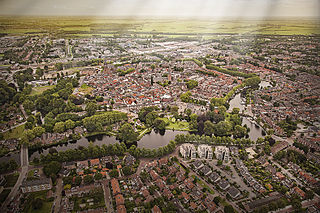
Woerden is a city and a municipality in central Netherlands. Due to its central location between Amsterdam, Rotterdam, The Hague, and Utrecht, and the fact that it has rail and road connections to those cities, it is a popular town for commuters who work in those cities.

Harmelen is a town in the Dutch province of Utrecht. It is a part of the municipality of Woerden, and lies about 6 km east of Woerden.

The Oude Rijn is a branch of the Rhine delta in the Dutch provinces of Utrecht and South Holland, starting west of Utrecht, at Harmelen, and running by a mechanical pumping station into the North Sea at Katwijk. Its present-day length is 52 kilometres.
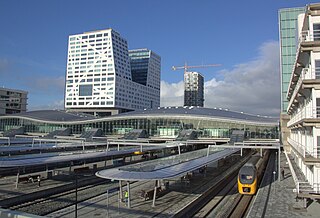
Utrecht Centraal, officially Station Utrecht Centraal, is the transit hub that integrates three bicycle parkings, two bus stations, two tram stops and the central railway station for Utrecht, Netherlands. It is the biggest train station in the Netherlands.

Rail transport in the Netherlands uses a dense railway network which connects nearly all major towns and cities. There are as many train stations as there are municipalities in the Netherlands. The network totals 3,223 route km (2,003 mi) on 6,830 kilometres (4,240 mi) of track; a line may run both ways, or two lines may run on major routes. Three-quarters of the lines have been electrified.

The history of rail transport in the Netherlands is generally considered to have begun on September 20, 1839, when the first train, drawn by De Arend, successfully made the 16 km (9.9 mi) trip from Amsterdam to Haarlem. However, the first plan for a railroad in the Netherlands was launched only shortly after the first railroad opened in Britain.

Woerden railway station is the railway station of Woerden, Netherlands. The railway station was opened on 21 May 1855 on the Utrecht–Rotterdam railway. In 1911 a new building was built in Jugendstil. During 1993-1996 the railway station was modernised, replacing the wooden roof and stairways by modern ones, while maintaining the Jugendstil building.
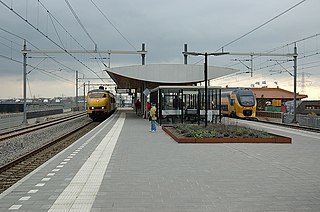
Breukelen is a railway station located in Breukelen, Netherlands. The station was opened on 18 December 1843 and is on the Amsterdam–Arnhem railway. It is also the northern end of the Harmelen–Breukelen railway. A new station was opened in 2002 nearer the A2 motorway and further from the town. For this the junction with the line to Harmelen and Woerden also moved.

Rotterdam Alexander is a combined metro and railway station in Rotterdam, Netherlands. It is located on the Utrecht–Rotterdam railway. It is named after Prins Alexander borough, and therefore indirectly after Alexander, Prince of Orange. Near the station is shopping mall Alexandrium situated.

Rotterdam Noord is a railway station in the city of Rotterdam in the Netherlands, located on the Utrecht–Rotterdam railway. It sits at the border between the two Rotterdam boroughs Noord and Hillegersberg-Schiebroek.

Schiedam Centrum is a railway station and metro station in Schiedam, just to the west of Rotterdam, Netherlands, on the railway line between The Hague and Rotterdam Centraal. Train services are operated by Nederlandse Spoorwegen, and metro, tram and bus services are operated by Rotterdamse Elektrische Tram.
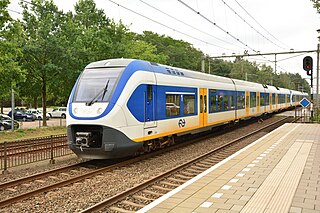
The Sprinter Lighttrain or SLT is an Electric Multiple Unit (EMU) train type operated by the Nederlandse Spoorwegen in the Netherlands. They were built from 2007 to 2012 by Bombardier (2400) and Siemens (2600). It is the successor of the Sprinter SGM train type.
The Halle train collision was a collision between two NMBS/SNCB passenger trains carrying a combined 250 to 300 people in Buizingen, in the municipality of Halle, Flemish Brabant, Belgium, on 15 February 2010. The accident occurred in snowy conditions at 08:28 CET (07:28 UTC), during rush hour, on railway line 96 (Brussels–Quévy) about 12 kilometres (7.5 mi) from Brussels between P-train E3678 from Leuven to Braine-le-Comte and IC-train E1707 from Quiévrain to Liège. A third train was able to come to a stop just in time. The collision killed 19 people and injured 171, making it the deadliest rail accident in Belgium in over fifty years.

The Weesp train disaster took place on 13 September 1918 near Weesp, Netherlands. With 41 deaths and 42 injuries, it was the largest train disaster in Dutch railway history until the 1962 Harmelen train disaster.
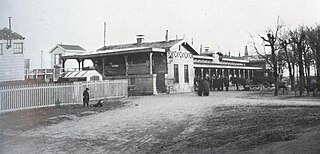
On 10 August, 1856 two passenger trains collided at the Amsterdam–Haarlem–Rotterdam railway near Delfshaven between Schiedam Centrum station and Rotterdam Centraal station, the Netherlands. Two carriages where destroyed with a third being severely damaged. Three passengers lost their lives and at least nine were injured.

On 21 April 2012 at 18:30 local time, two trains were involved in a head-on collision at Westerpark, near Sloterdijk, in the west of Amsterdam, Netherlands. Approximately 117 people were injured, one of whom later died in hospital. The collision is thought to have been caused by the driver of one of the trains passing a red signal.
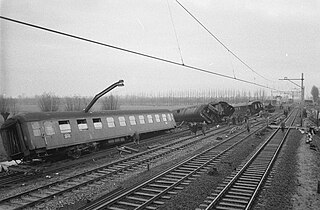
The Woerden train accident was a railway accident on 21 November 1960 at around 20:10 in Woerden, Netherlands near the Cattenbroek rail crossing.
The 1874 Warmond train accident was a train collision between a passenger train and a freight train at the Amsterdam–Haarlem–Rotterdam railway near Warmond railway station between Leiden and Warmond, in the Netherlands on 14 August 1874. A passenger and one of the drivers were killed, and over 30 passengers were injured. The wife of the train driver died of shock after hearing her husband was killed.



















